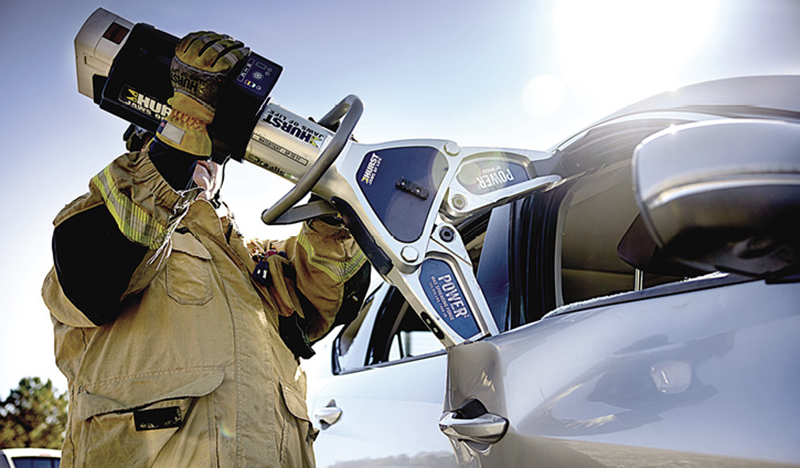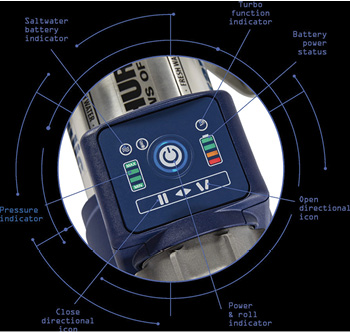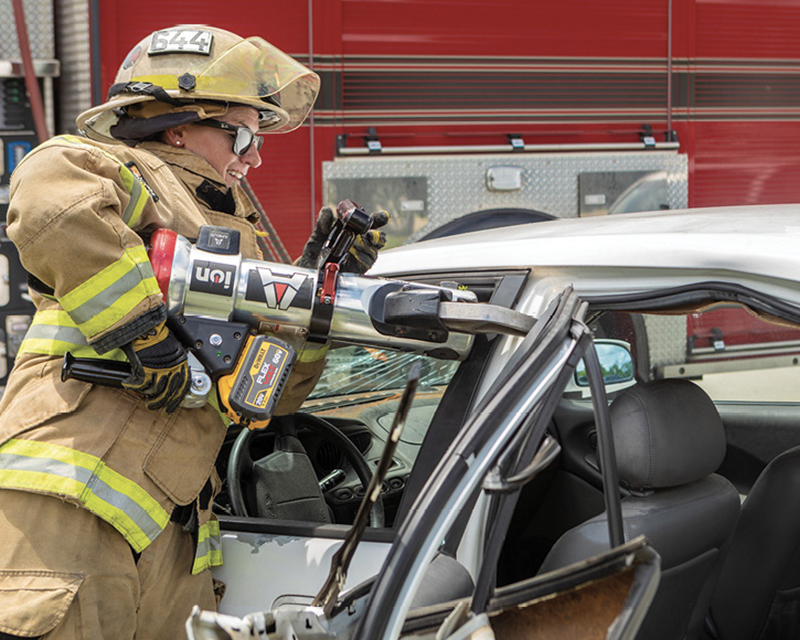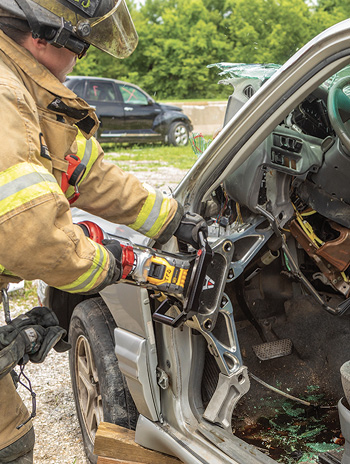
Battery-powered hydraulic rescue tools have taken the rescue world by storm, giving traditional hosed hydraulic rescue tools a run for their money. The attraction of battery-powered tools, say many departments, is in their maneuverability, ease of use and storage, and ability to be taken to locations that a hosed tool couldn’t reach.
Michael Canon, director of rescue sales for IDEX Fire and Safety’s HURST™ Jaws of Life®, believes smart battery technology has changed so much that it allows firefighters greater abilities in battery life and cycling limits but also in the versatility offered in use of the tools.
- Battery-Operated Hydraulic Tools Make Big Inroads on Rescue Trucks and Rescue-Pumpers
- Hillsborough County (FL) Fire Rescue Turns to Holmatro for Large Order of Hydraulic Rescue Tools
- Rescue-Pumpers Continue in Popularity Among Many Suburban, Rural Fire Departments
- Power, Speed, and Weight Are Factors in Extrication Tool Design

1 A firefighter uses a HURST Jaws of Life eDraulic 3.0 battery-powered spreader. (Photos 1-3 courtesy of HURST Jaws of Life.)

2 The Hurst eDraulic 3.0 battery-powered ram in use.

3 The eDraulic 3.0 battery-powered rescue tools made by HURST have a dashboard that provides real-time feedback on the tool’s status.
“The updates in batteries have changed the equation when it comes to run time for battery-powered tools,” Canon observes. He says that the most common demand from fire departments is for HURST’s SP 555 28-inch spreader, which is very popular in use on heavy rescue units. “We also have the SP 777 spreader with a 32-inch spread that gives firefighters more versatility,” he adds.
Canon points out that a big change in the auto industry has been an increase in the tensile strength of cars. “The lower profiles of the A and B posts are getting wider, and automakers are adding wider and more layers of high-strength steel,” he says. “It’s getting very difficult to remove the B post without the cutters swinging into the patient.” Canon says HURST makes a cutter model with a blade that has a 90-degree curve open at the yoke (center bolt) to prevent the cutter from swinging into the patient.
Canon says, “With our new E3 platform, the cutter has roll detection technology that warns if the cutter turns on its own axis 15 degrees or more. If that happens, a dash button goes red, and the cutter will take the roll to prevent the blade and/or the bolt from breaking. Our eDraulic 3.0 smart rescue tools have a dashboard that provides up-to-the-minute on the tools’ feedback status. Plus, we have the industry’s first patented watertight design for fresh and salt water.”
Chuck Sheaffer, sales manager for AMKUS Rescue Systems, says his company introduced a new line of tools at FDIC International 2022. “Our new spreader, cutter, and combi tool are designed to replace the 2.0 original battery tools,” Sheaffer says. “These are midrange tools, much faster than the original 2.0 tools. We have the IS290 29-inch spreader that’s shorter than our full-sized hosed tool; an IC650 cutter with a 5½-inch blade opening, the same as our 700 cutter; and a ICT616 combi tool with a 15-inch opening.”

4 A firefighter uses an AMKUS battery-powered spreader. (Photos 4-6 courtesy of AMKUS Rescue Systems.)

5 Cutting a B post with an AMKUS battery-powered cutter.

6 Lifting a dashboard and steering wheel with an AMKUS battery-powered spreader.
Sheaffer points out that in the past year, the AMKUS IS32 spreader and the IC700 and 720 cutters have proven to be very popular tools among rescue crews. “Our full-size cutters and spreaders are some of the fastest tools on the market but might be a bit heavy,” he says, “but our midrange tools are at least 5 pounds lighter on the cutter and spreader and 10 pounds lighter on the combi too,” he says.
JoAnn Tyler, national sales manager for Holmatro USA, says that last year Holmatro introduced the Pentheon range of battery-powered hydraulic rescue tools. “We integrated the pump and motor on the Pentheon tools, which allowed us to slim them down and lighten their weight,” Tyler notes. “We offer four models each of cutter, spreader, combi, and ram.”

7 Holmatro USA’s PCU50 cutter in action. (Photos 7-8 courtesy of Holmatro USA.)

8 Holmatro’s PTR50 Telescopic Ram.
With the spreaders, Holmatro has a 32-inch version, two at 28½ inches with two different spread forces, and one at 20 inches spread. The cutters range from the lightest and smallest-opening tool at 6.7 inches for two models with different cutting forces to those with larger hydraulic cylinders at 7.2 and 8.1 inches.
Holmatro’s combi tools run from its 11-inch and 14-inch lightweight tools to its popular PCT 14 with a 14-inch opening and the PCT 50 and 60 with 150,000 pounds and 208,000 pounds of cutting force, respectively, says Tyler. The company’s most popular telescopic ram is the PTR50, which goes from 22.8 inches retracted to 71 inches extended with a Smart Ram extension.
Mike Beharry, president of Midwest Rescue Products Inc., North American distributor for Ogura Rescue Tools, says his company offers three lines of hydraulic rescue tool products as well as rebar cutters and breaching tools. “Most popular right now is the BC300X line, which is used very well in auto extrication situations,” Beharry says. “It’s a combi tool integrated with no removable heads.”

9 Ogura Rescue Tools RP-S505. (Photo 9 courtesy of Ogura Rescue Tools.)
Beharry adds that Ogura makes the Hydraulic Rescue System (HRS) that allows firefighters to mix and match removable tool heads. “We are coming out with the RP series that has the motor and pump built into the tool head,” he says. “We also have two models of carbide tip flush cutters for rebar that are versatile and easy to use.”
ALAN M. PETRILLO is a Tucson, Arizona-based journalist, the author of three novels and five nonfiction books, and a member of the Fire Apparatus & Emergency Equipment Editorial Advisory Board. He served 22 years with the Verdoy (NY) Fire Department, including in the position of chief.

